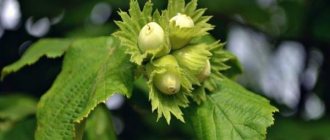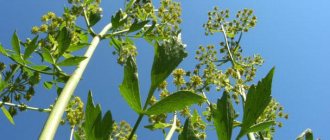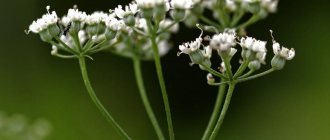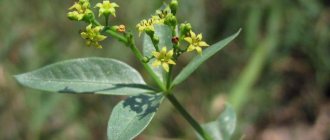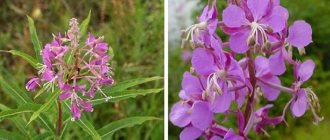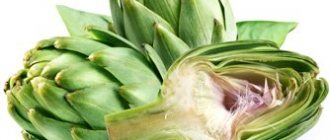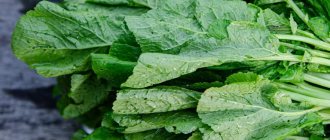Loading…
Loading…
The name of the plant “Oxalis” fully reflects its sour taste. The beneficial properties of sorrel and contraindications to its use are determined by the presence of oxalic acid in it. The grass can be found in mixed forests and swampy areas in the central part of Russia. here it is called forest sorrel or hare cabbage. Mexico is considered the real homeland of wood sorrel. It also grows in other tropical and subtropical countries - Turkey, Mongolia, Africa, Australia, China, America. Decorative varieties are grown indoors. The culture is unpretentious and light-loving, highly valued by florists.
Medicinal properties
Oxalis is classified as a mildly poisonous plant and is used mainly for food and medicinal purposes.
Since ancient times, oxalis has been considered a valuable medicinal plant. The aerial part and flowers of sorrel were used for scurvy; they also made a powder from it, which was used to treat ulcers and wounds, and was used as an antidote for poisoning with mercury and arsenic compounds. In addition, the nutritional properties of this plant have always been valued. Tea was made from it, used instead of vinegar, and added to cabbage soup and kvass.
Due to the high content of vitamin C, this plant can be used to fight colds, strengthen the immune system and generally strengthen the body. In folk medicine, the anthelmintic, anti-inflammatory, choleretic, wound-healing and diuretic properties of oxalis are also known. The plant has a beneficial effect on metabolism, increases the acidity of gastric juice, eliminates dyspeptic symptoms, improves appetite, and eliminates bad breath. Oxalis decoction is a good thirst quencher. Preparations based on this plant help eliminate heartburn, vomiting, and help cleanse the body of toxins.
Rules for collecting, drying, storing herbs
To prepare homemade medicines, the entire above-ground part of the herb (flowers, leaves, young stems) is used. It is recommended to go stock up on medicinal plant materials during the flowering period - after the start of fruiting, the amount of useful elements decreases significantly.
Cut off the entire above-ground part of the plant, leaving small stumps (up to 10 cm). You can immediately knit in bunches or put them in a basket. At home, hang the bundles in a dry, warm room.
For drying, it is also recommended to use wide baking sheets and special racks. Spread the plant material in a thin layer - this will speed up drying and prevent the grass from rotting.
Drying on baking sheets is carried out under awnings. It is imperative to ensure good ventilation - without access to fresh air, the valuable plant component will become moldy; using herbs with signs of spoilage for treatment is strictly prohibited.
Article for you:
Medicinal properties of the sapling and its use in folk medicine
While drying, stir the vegetable layer and periodically check for readiness. This is easy to do - squeeze a handful of grass with your hands; if it starts to crumble, put it in storage.
Place the prepared plant materials in glass containers and canvas bags. Use linen containers only in cool rooms with low humidity. The shelf life of sorrel is up to two years.
The herb is not sold in pharmacies - the healing qualities of the plant are not recognized by official medicine. You will have to independently go away from noisy highways and large industries in order to stock up on a valuable component for home treatment.
Dosage forms
Leaves, grass and flowers of wood sorrel are used for medicinal purposes. The highest concentration of biologically active substances in the plant occurs during the flowering period - in the May-June period. This is the best time to collect raw materials. The plant has medicinal properties both in fresh and dried form. For storage, the collected raw materials are slightly crushed and dried in air or in special dryers at a temperature not exceeding 40˚C. Raw materials prepared in this way should be stored in wooden or cardboard containers for no more than a year.
Description and characteristics of culture
The “oxalis” family is large, numbering 8 genera and more than 800 species, having a wide variety of shapes, sizes and colors. The plant spreads along the ground, creating a “carpet” that is soft to the touch. Most representatives have three-lobed thin leaves planted on long pubescent cuttings. Outwardly, they resemble clover leaves. There are specimens whose leaves are divided into 4, 5, 9 lobes.
At night and in bad weather, oxalis flowers tend to close, and the leaves tend to fold and fall to the ground.
The foliage shades are very diverse, some varieties have two or three colors. The flowers are single and small, light in color, with a darker spot at the base of the petals. After flowering, the capsule ripens; in some species, the sorrel berry ripens. Typically, ants carry plant seeds over fairly distant distances, which is how the crop reproduces and spreads.
Application
When fresh, juice is prepared from the plant, which helps cleanse the body of heavy metals, thereby providing an antitumor effect. Also, fresh sorrel juice is recommended for use by people with impaired metabolism and digestive problems, for diarrhea and for mouth rinsing with stomatitis. The pulp from the fresh leaves of the plant helps heal purulent wounds. Oxalis juice has antiseptic properties and is effective against scabies. Also, in its raw form, sorrel is used for hypo- and avitaminosis C, hypoacid gastritis and for the treatment of anorexia.
Oxalis tinctures are used for various diseases of the stomach, liver, bladder and gall bladder, enuresis, jaundice, and scurvy. Also, a tincture of the plant is used for external use to accelerate wound healing.
Medicinal decoctions are prepared from sorrel. A decoction of milk has diuretic and hemostatic properties and is taken for colds. A decoction of water is used for tuberculous lesions of the lymph nodes, heart neurosis, stomach cancer and for the prevention of atherosclerosis. In addition, a decoction of sorrel is used to remove helminths; it can also be used for children.
Oxalis - malicious weeds
As botanists say, these are invasive, that is, alien plants that grow weeds in new places. You need to be able to accurately recognize oxalis weeds by their appearance so that you never buy them under the guise of decorative ones. Many summer residents have experienced all the difficulties of fighting sorrel weeds. So look carefully, remember firmly.
Oxalis dillenii
Originally from North America. The flowers are small, yellow.
Oxalis Dillenius
Oxalis weeds are very similar to each other. They are united by common features: they are low, with small leaves and flowers.
Oxalis stricta
Native to North and Central America.
Oxalis straight, photo Samdolis
It quickly captures new territories thanks not only to its well-developed creeping rhizome, but also to the amazing ability of the seeds to scatter in all directions (and over quite a considerable distance) at the slightest touch to the ripe capsules.
Carob sorrel (Oxalis corniculata)
Originally from Central America. Its appearance can be misleading: well, who can imagine that this lovely beauty with dark purple trifoliate small leaves and small yellow flowers is a malicious weed?
Carob oxalis, photo from Mardg
I don’t know how the carob plant got into my dacha, but now every year I am doomed to tedious painstaking work when I have to choose it from the ophiopogon.
I hope our journey into the wonderful world of such different wood sours was not only interesting, but also useful. Now you will probably be able to distinguish a flexible decorative species from an aggressive weed. Think carefully about whether it’s worth inviting a little charmer to your site if she looks like the last 3 species.
Traditional medicine recipes
To prepare the decoction, pour 2 teaspoons of dry herbal raw materials into a glass of clean water, put on fire and bring to a boil, then leave to infuse until cooled. The cooled decoction of the plant must be filtered and topped up with boiled water to the original volume. The decoction prepared in this way should be taken 3 times a day, half a glass with meals. It is used to improve digestion, for gargling with sore throats, washing wounds and rinsing bruises.
Oxalis tincture is prepared from 50 g of dry plant material and a 500 ml bottle of vodka. The plant should be filled with vodka and left to infuse in a dry, dark place for 10 days, after which the resulting infusion should be squeezed out. Before use, the infusion must be diluted with clean water.
The juice of the plant is taken by mixing with honey in a one-to-one ratio, a tablespoon several times a day. The juice is effective for diarrhea and inflammatory diseases, ulcerative stomatitis (diluted), for preparing compresses for external use on diathesis, boils and abscesses.
What is a plant
It belongs to the genus of the same name in the Kislichnye family.
This is a herbaceous perennial plant, low - 5-10 cm in height. It has a creeping thin rhizome of a reddish color. Mycophycete fungi live on the roots. The plant has short shoots, trifoliate, clover-like, soft green leaves on high petioles. In rain, at night and in adverse conditions, or if you touch them, they droop and collapse. In winter, under the snow, they remain green. The leaves are sour due to oxalic acid. Oxalis blooms in May or June, with inconspicuous small flowers with white petals with transparent veins. Oxalis in Russia grows in the regions of the middle zone, the Far East and Siberia. It can be found in dark forests consisting of coniferous trees and deciduous trees. Plants grow in ravines, along the banks of rivers and streams, near swamps. Near the water they cover the ground with a continuous carpet.
Carob oxalis in the garden
This variety of sorrel is very common in domestic gardens. Along with its usefulness, the plant is also distinguished by its excellent decorative properties, which, coupled with the vitality inherent in most representatives of the genus, makes it possible to create unique picturesque landscapes of alpine hills and rockeries. Oxalis is used in the garden interior as a ground cover or border plant. Purple-cherry islands, which quickly form and remain decorative for a long time, give the artificial structure natural beauty and naturalness. During flowering, small yellow star flowers highlight the unusual shade of foliage and soon turn into small pods directed upward.
If desired, miniature palm trees can be formed from sorrel bushes by cutting off the leaves from the main shoot and leaving a crown of a known shape. She tolerates such pruning calmly and continues to develop as before. Another way to decorate a garden space that this small herb can do is to grow it in hanging pots. This spectacular design technique is adopted by many gardeners today.
The unpretentiousness and high shade tolerance of the plant allow it to be planted in the darkest, unlit corners of the garden, decorating unfavorable places.
Description of wood sorrel (Oxalis)
Oxalis is a shrub or herbaceous plant. Among the huge variety of oxalis species, there are annual or perennial representatives. Most often you can find herbaceous species; they are grown as ampelous or ground cover decorative deciduous specimens. In most species, the leaves are three or four lobed, less commonly found with five, six or nine lobes, on long petioles, and have a peculiar sour taste.
The underground part of oxalis, depending on the type, is a rhizome, tuber or bulb. Modest, but very attractive flowers have white, yellow, pink, purple colors and are collected in an umbrella-shaped inflorescence. Many oxalis fold their leaves at night, in bright sun or before rain.
Since ancient times, certain types of oxalis have been consumed as food. The Indians specially cultivated oxalis and ate boiled tubers containing large amounts of starch.
Oxalis appeared as an indoor crop in the 17th century and won the hearts of flower growers in many countries with its amazing appearance and unpretentiousness. In everyday life, the name “Butterfly Flower” is used for oxalis grown indoors.
Oxalis, or common wood sorrel (Oxalis acetosella).

